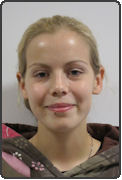Group
Members

"The present is the key to the past"
Uniformitarianism; James Hutton
..can the past also be the key to the future?
Lyndsey Fox (Ph.D. Student)

Climate Variability during the Mid-Miocene Climate Optimum
Background
During the early to middle Miocene (23-15 Ma) the climate fluctuated greatly, with cyclic periods of Antarctic glaciation and climatic warming termed the “mid Miocene climate optimum”. Integrated Ocean Drilling Program (IODP) Expedition 320/321 drilled 8 sites in the equatorial Pacific Ocean (Fig. 1). Site U1338 recovered lower-middle Miocene sediments with high sedimentation rates (30m/myr), continuous recovery, and orbital cyclicity (Lyle et al., 2009). Previous studies of the lower and interval have been hindered by the absence of biogenic carbonate (e.g., Leg 199). At Site U1338 planktonic foraminiferal are abundant in the lower and middle Miocene sediments and assemblages are well preserved and diverse, allowing for studies of foraminiferal biostratigraphy and biotic evolution. This site therefore provides the opportunity to produce the first detailed multispecies record of planktonic foraminiferal geochemistry to document climate variability in the early to middle Miocene.
Procedures
This study concentrates on the early to mid Miocene climate, specifically from 15-17 Ma. Samples from Site U1338 will analyzed every 10 cm (equivalent to 3000 kyr resolution). Work will be in collaboration with Ann Holbourn (Germany) who is producing a detailed benthic foraminiferal stable isotope record at this site
Aims and Objectives
The aim of this project is to produce a detailed climate record of the early to middle Miocene.
The objectives are:
Determine the nature and variability of early-middle Miocene climate and the relationship to orbital variations in solar insolation. Investigate changes in the thermal and nutrient structure of the ocean during the development of “mid Miocene climate optimum”. Examine the relationship between climatic warming and planktonic foraminiferal evolution
Background
I graduated from the University of Plymouth in 2010 with a Masters of Geology degree, my final year project investigated the Micropalaeontology of the Cambridge Greensand. I first began studying micropalaeontology in 2009 when I was awarded a Nuffield bursary to research planktonic foraminifera at the Cenomanian-Turonian boundary in Austria, and I haven't looked up (from the microscope) since.
email: eelrf@leeds.ac.uk
web: http://homepages.see.leeds.ac.uk/~eelrf/











